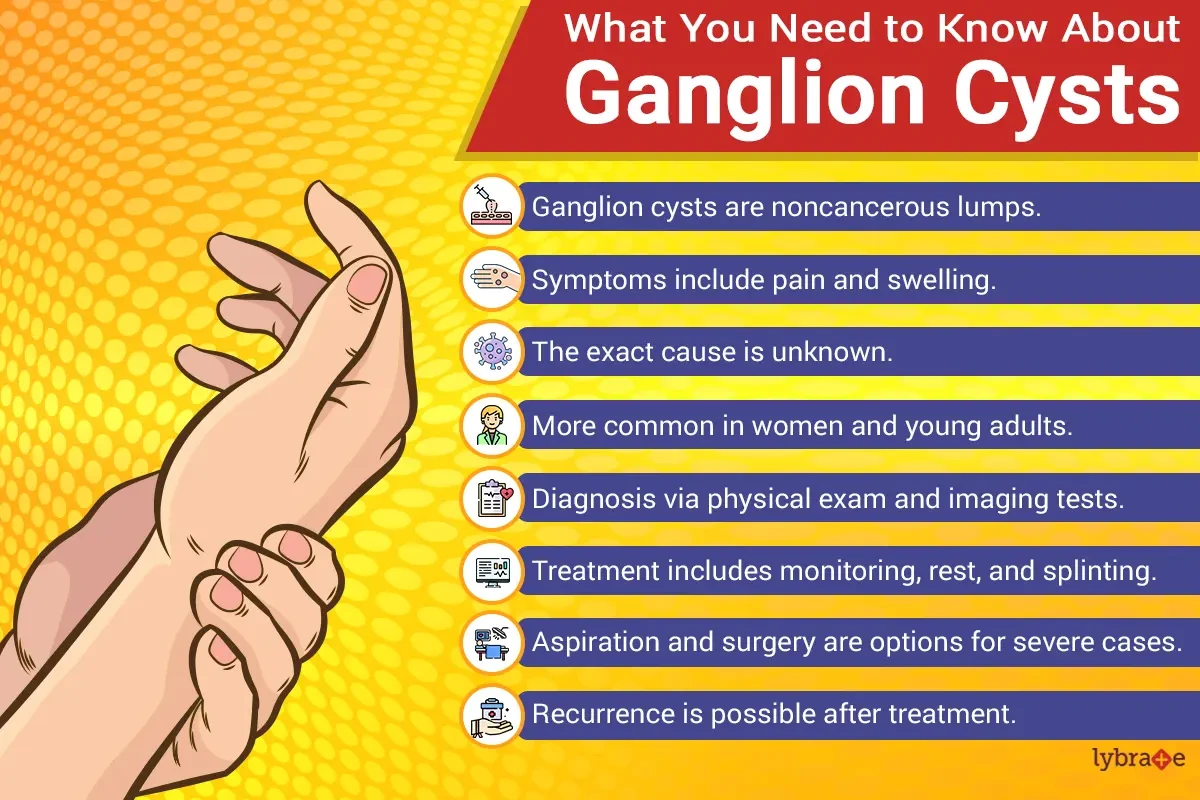Unlock the secrets of ganglion cysts: Learn about their causes, symptoms, and innovative treatment options in our comprehensive guide. Empower yourself with knowledge for better health.
Introduction
Ganglion cysts, those noncancerous lumps that often appear on wrists or hands, can be a source of discomfort and curiosity for many. Filled with a jelly-like fluid, these cysts vary in size and impact, fluctuating with your activity levels. While generally harmless, understanding their nature, causes, and treatment options is crucial for anyone affected by or interested in these common lumps. Dive into our guide to gain insights into ganglion cysts and how they can be managed or treated, ensuring you’re equipped with the knowledge to handle this condition confidently.

Table of Contents
Causes of Ganglion Cysts
While the precise origins of ganglion cysts are not fully understood, the prevailing theory is that they develop due to a flaw or weakness in the joint capsule or tendon sheath. This weakness allows the soft tissue to bulge outwards, forming a cyst. Here are some factors that might contribute to their formation:
Joint or Tendon Stress
Repetitive motions or stress on a joint or tendon can increase the likelihood of a cyst forming. This is often seen in athletes or individuals with jobs that require repetitive hand and wrist movements.
Trauma
A single traumatic event to a joint or tendon might lead to the development of a cyst. The trauma could cause a tear or weakness in the joint’s connective tissue, leading to cyst formation.
Mechanical Changes
Changes in the surrounding joint or tendon tissue, possibly due to age or injury, might create conditions favorable for cyst development.
Hormonal Factors
Some researchers speculate that hormonal changes might influence the development of ganglion cysts, though this connection requires further study.
Symptoms of Ganglion Cysts

Ganglion cysts present a range of symptoms, primarily influenced by their size and location. Here’s a closer look at the common symptoms:
Visible Lump
The most noticeable symptom is a lump that forms over a joint or tendon. The lump may be small and inconspicuous or large enough to be clearly visible. Its size can fluctuate, often increasing with joint activity and decreasing with rest.
Discomfort or Pain
While many ganglion cysts are painless, they can cause discomfort or pain, especially when the affected joint is used repetitively. The pain may result from the cyst pressing against surrounding tissues or from the strain of the overlying skin.
Tingling or Burning Sensation
If a cyst presses on a nerve, it can cause sensations such as tingling, burning, or even numbness in the affected area. This is more common when the cyst is located in a place where nerves are more superficial or confined.
Weakness or Muscle Fatigue
Large cysts can interfere with the normal movement of a joint or the function of tendons, leading to muscle weakness or fatigue. This might make it difficult to perform tasks that require fine motor skills or to maintain a strong grip.
Understanding these causes and symptoms is crucial for recognizing ganglion cysts early and seeking appropriate treatment. While they are generally not harmful, their impact on daily activities and overall quality of life can be significant for some individuals. If you suspect you have a ganglion cyst, especially if it causes pain or functional impairment, consulting a healthcare provider is advisable for a proper diagnosis and to discuss potential treatment options.
Diagnosing Ganglion Cysts
The diagnosis of ganglion cysts primarily involves a physical examination and a review of the patient’s medical history. During the examination, a healthcare provider may:
Physical Examination
Look and feel the cyst, noting its size, shape, and whether it moves easily. The doctor might shine a light through the cyst (transillumination) to determine if it’s solid or filled with fluid.
Pressure Application
Apply pressure to see if it causes tenderness or discomfort, which helps in assessing the cyst’s impact on the patient’s comfort and joint functionality.
Imaging Tests
In some cases, to rule out other conditions (like arthritis or tumors) and to confirm the diagnosis, imaging tests such as ultrasound or Magnetic Resonance Imaging (MRI) might be used. These tests provide detailed images of the inside of your body, showing the cyst’s structure and its relation to surrounding tissues.
Treatment Options
Treatment for ganglion cysts varies depending on the symptoms and the cyst’s effect on joint movement:
Observation
Many ganglion cysts are asymptomatic and may resolve on their own without any treatment. In such cases, observation is recommended, where the cyst’s progress is monitored over time.
Aspiration
This procedure involves draining the fluid from the cyst with a needle. It’s a minimally invasive method that can provide relief from discomfort but has a higher rate of recurrence compared to surgical removal.
Surgery
Surgical removal of the cyst may be considered if it returns after aspiration, causes significant pain, or restricts joint movement. Surgery aims to remove the cyst and part of the joint capsule or tendon sheath, which is the root of the cyst. This option has a lower recurrence rate but comes with the usual risks of surgery, such as infection or nerve damage.

When to See a Doctor
While ganglion cysts are generally not harmful, certain signs warrant a consultation with a healthcare provider:
- Pain: If the cyst causes pain or discomfort.
- Impaired Joint Movement: If the cyst’s location or size interferes with the normal movement of a joint.
- Nerve Compression: Tingling, numbness, or muscle weakness may indicate that the cyst is pressing on a nerve.
- Cosmetic Concerns: Some individuals may wish to have a cyst removed for aesthetic reasons or because its appearance causes concern.
Ganglion cysts are common and often harmless, but their treatment depends on the symptoms they cause. A healthcare provider can offer guidance on the best course of action based on the individual’s specific situation.
| Arch Support |
| Arch Supports |
| Best Arch Support Insoles |
| Best Insole for Plantar Fasciitis |
| Insole for Flat Feet |
Frequently Asked Questions
Q: What exactly are ganglion cysts?
A: Ganglion cysts are benign lumps filled with a jelly-like fluid, commonly found along the tendons or joints of the wrists, hands, ankles, and feet.
Q: How are ganglion cysts diagnosed?
A: Diagnosis typically involves a physical examination, history review, and possibly imaging tests like ultrasound or MRI to rule out other conditions.
Q: Can ganglion cysts go away on their own?
A: Yes, many ganglion cysts do not require treatment and may disappear over time. However, observation is key to monitor any changes.
Q: What treatment options are available for ganglion cysts?
A: Treatment may include observation, aspiration (fluid drainage), or surgery, depending on the cyst’s symptoms and impact on joint movement.
Q: When should I see a doctor for a ganglion cyst?
A: Consult a healthcare provider if the cyst causes pain, interferes with joint movement, induces tingling or numbness, or if its appearance concerns you.
Conclusion
Ganglion cysts, while typically harmless, warrant attention and understanding due to their potential to cause discomfort or impact daily activities. Whether you’re dealing with a cyst yourself or simply seeking to learn more, it’s important to recognize the signs and know when to seek medical advice. With the right approach, managing or treating ganglion cysts can lead to relief and a return to normal activities. Remember, knowledge is power—empower yourself by staying informed about your health and treatment options.





